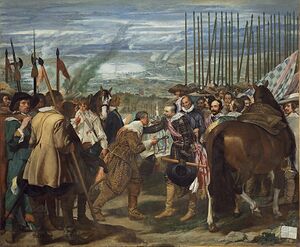Second Termian War
| Second Termian War | |||||||
|---|---|---|---|---|---|---|---|
| Part of Carto-Pelaxian Wars of Independence | |||||||
 Battle of Vadorrojo | |||||||
| |||||||
| Belligerents | |||||||
| Pelaxia | Caphiria | ||||||
The military conflict known as the Second Termian Wars (1620-1627) was a pivotal episode in the Wars of Independence between the Kingdom of Pelaxia and Caphiria. At its core, the war was ignited by Caphiria's aggressive endeavor to regain control over the Province of Pelaxia, which had recently rejected its vassalage. Moreover, the control of the Kindred Sea, a vital maritime route, was a central stake in this high-stakes geopolitical struggle. The contested territory of Termia, characterized by its treacherous marshes and meandering rivers, held profound strategic significance as it controlled access to both the Kindred Sea and the vital Province of Cartadania.The war unfolded as a gritty and protracted struggle, with limited use of firearms and a reliance on traditional tactics and disciplined formations.
At the heart of the conflict was the newly formed professional army of Pelaxia, known as the "Las Huestes Reales". This force showcased its prowess in disciplined warfare, particularly with their utilization of heavy pikemen and the maneuvering expertise of "Rodeleros" ("Sword and Buckler Men") in the challenging swamp terrain. These tactics proved essential for navigating the challenging environment, where quicksand, dense foliage, and treacherous waterways demanded a unique approach. The clashes were marked by the grinding nature of swamp warfare, characterized by mud-soaked battles and grueling marches. The conflict gained a reputation for its gruesome nature, where soldiers contended not only with the enemy but also with the inhospitable environment. Firearm usage was limited, intensifying the reliance on close-quarter combat and skillful coordination of both big military formations and also more attritional tactits and lighter units.
The culmination of the conflict was the Treaty of Broda, signed in 1627. The treaty marked a turning point in Pelaxia's struggle for independence, cementing its status as an independent kingdom. The terms of the treaty awarded Pelaxia partial control over the Termian Delta and its intricate network of rivers. This concession granted the kingdom a strategic foothold, solidifying its control over a critical access point to the Kindred Sea and the prized Province of Cartadania.
In conclusion, the Second Termian Wars emerged as a crucial theater in the Wars of Independence, underscoring the resilience and strategic acumen of the Kingdom of Pelaxia. Against the backdrop of marshy battlegrounds and limited firearm usage, the conflict demonstrated the kingdom's disciplined warfare and culminated in the Treaty of Broda, securing its independence and strategic territorial gains.